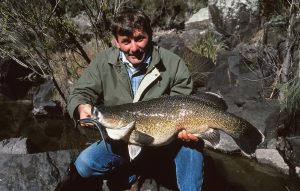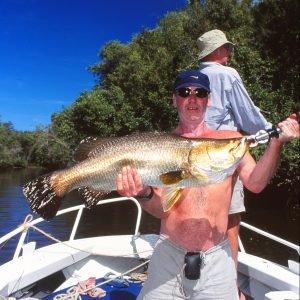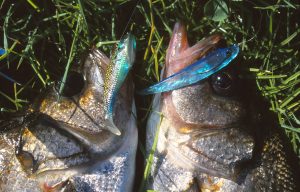Being a fishing guide I carry an ‘emergency’ pack of craptacular excuses to cover the slow days. I also get to hear fishing theories repeated ad nauseam. One of the favourite’s common to guides and punters alike is the one about the barometer. It goes like this; the falling and low barometer causes bad fishing and the rising and high barometer generally produces good fishing. There’s a plethora of theories as to why this happens but the most common I’ve heard is that it affects the fish’s swim bladder. The bush biologists conclude that a low pressure system causes the swim bladder to expand and make the fish feel ‘full’, hence suppressing the appetite — the human equivalent of stomach stapling. While I’m certain that shifting barometric pressure does have some effect on saltwater fish and to a much greater extent on freshwater fish , I’m thoroughly convinced that the common myth as to why , is complete and absolute bunkum .

Consider the following.
The average pressure exerted at sea level by our entire atmosphere is 1000 millibars (1 atmosphere). That’s the weight of the entire atmosphere from space to the earth’s surface. You only have to go down ten meters in the water to achieve another 1000 millibars. So at 10 meters depth you have 2000mb or 2 atmospheres (atmospheric pressure + water pressure). At 20 meters you have 3 atmospheres and so on .
Variation caused by the H and L pressure systems moving around the earth moves between a low of 950 and a high of 1050. That’s a 100mb variation .This represents 10% variation of the entire atmospheric pressure of 1000mb.
The theory starts to become very flimsy when you realize that a fish would only have to move half a meter, up or down, to compensate for the greatest variation in barometric pressure that it’s ever likely to encounter. Every 1 m of water represents 100mb. And the deeper you go the less relevant a 100mb change becomes. 100mb in 10 m of water represents 10% but 100mb in 100m is only a 1% change
The tide height alone, in most places, would contribute to at least 2 times as much pressure change as would ever be caused by changes in barometric pressure. In some places like the Kimberly in north western Australia, where the tide rises 12 m , this would have an effect of producing 12 times atmospheric variation .
We regularly encounter kingfish on our sounder at 10 meters, that will swim to the surface to take bait. This accent represents the equivalent of 10 times the worst change in atmospheric pressure. You know that Bass sitting at 3 meters will bolt to the surface to take a cicada and in the process will experience 3 times the average pressure swing. If his air bladder expanded during that accent, as the theory proposes, then by the time he got to the cicada he would have lost his appetite.

In plain terms, a fish sitting at a fixed height off the bottom, as they do, in 20m of water would experience 2 times the worst that atmospheric pressure could dish up, simply as a result of a 2m tide. Furthermore the fish would only have to move up 50cm up or down to completely negate any effect felt by a full swing of a barometric pressure up or down to 1050 or 950 from the average of 1000mb. Lastly if the same fish swum up just 10 m to grab prey, as many fish do, it would experience the equivalent of 10 times the worst atmospheric pressure change. Fish experience changes in pressure in their everyday life that far outweigh anything atmospheric pressure can dish up. And the deeper it gets the less it matters.
Clearly atmospheric pressure variation is not an issue for fish.
Here’s an alternate theory;
The lower the pressure the less able water becomes to assimilate oxygen from the atmosphere.
To add to this, aquatic plants, including planktonic algae are the main contributor to the dissolved oxygen (DO) content of water, particularly freshwater environments, as a by-product of photosynthesis. They take in co2, split off the C for building and spit out the O. Photosynthesis slows down dramatically in the low light conditions that usually accompany a cloudy low pressure system. In addition to this rough conditions created by a low pressure storms cause the water to become cloudy and inhibit light penetration, hence further slowing down photosynthesis. To further exaggerate the affects, plants flip flop in low light and start to consume oxygen rather than produce it. Even worse, lowly oxygenated water can cause toxic effects such as the release of ammonia and sulphides from sediments. It’s a run-away effect that can spiral out of control very quickly.
On the flip side, high pressure systems are often accompanied by clear skies , bright sunlight and glassy water surface due to low winds. Flat water allows greater , more even and consistent light penetration than does a choppy surface. This all adds up to increased photosynthesis and increased dissolved oxygen

I keep aquarium fish and it is very apparent that oxygen deficiency has a greater effect on them than any other variable– including PH and temperature. Oxygen deficiency will kill in minutes where temperature and PH usually take days if conditions are not rectified. Furthermore fish will adapt to slow PH and temp change to some degree. They will not adapt to lack of oxygen. They very quickly stop feeding, become lethargic and in worse case die. In fact most of the big fish kills in the wild are ultimately a result of oxygen depletion. Bigger fish will be affected by oxygen depletion first. The effects of dissolved oxygen levels on fish should not be underestimated as they are one of the fastest changing variables.
Prolonged or rapid changes in PH will however have some effect on fish’s behaviour. As co2 levels increase in water ph goes down which means it becomes more acidic. During a sunny day aquatic plants remove co2 from the water which helps raise or at least stabilize PH. But during a cloudy day where plants are not photosynthesising and hence not using co2 the Ph will drop. Even worse, plants will actually produce c02 during this period adding further to PH drop. If this goes on for a number of days PH will drop considerably. The amount and speed of drop will vary between waterways depending on the levels of carbonate hardness (KH) in the water. This is a much greater issue in fresh water than in salt water as the general hardness (GH) of saltwater makes its PH much more stable. Hence adding evidence as to why freshwater fish are much more affected by low pressure weather.
Storms common to low fronts, particularly in summer, are known to break thermo clines, having the effect of mixing oxygen depleted water from the deep with sufficiently oxygenated surface water. The overall effect of this is usually a general oxygen deficiency. As you might be starting to notice there’s nothing good about low pressure systems from a fish’s perspective.

It’s my theory that oxygen deficiency, change in PH and a drop in water temperatures are the major contributor to ‘shutdowns’ in fish. This comes about as an indirect result of the generally bad, cold and cloudy, low light weather associated with low pressure systems.
Fishes metabolism is directly linked to water temps. Fish will also absorb some direct radiated heat from sunlight, on a sunny day, irrespective of water temps – an advantage lost on an over cast day. So not only does their metabolism slow down because they are cold, but they also feel bad because they have to work harder to get oxygen and their environment has become more acidic . No wonder they stop feeding and I’m sure I don’t have to explain why they feed up ‘big time’ just before the front hits. The theory also supports why fresh water fish are more affected. Bodies of freshwater, being smaller in volume, cool down a lot quicker, and are subject to flushes of cold rainwater which drop temps and cause water clouding. They also rely heavily on aquatic vegetation for their oxygen – at least much more so than the ocean. Aquatic plants provide a far better distribution of their released oxygen as they do it from the bottom up. Dissolved atmospheric oxygen, in a still body of water, will tend to stay near the surface. Once water near the surface becomes ‘saturated’ with oxygen it won’t take on any more until turbulence or a current move that water on and replace it with less oxygenated water. Plants anchored to the bottom will oxygenate the deeper layers of water found in still freshwater lakes that would otherwise receive no surface oxygen. This is mainly applicable to the lake margins (where ‘co-incidentally’ we find most fish activity) as aquatic plants don’t grow in very deep water where light penetration is insufficient, even in clear water. This is why people can often pre-empt an impending fish kill with reports of “fish gulping at the surface”
My aquarium fish congregate around the turbulence created by the filter outlet during periods of low oxygen. Water absorbs and distributes oxygen better when it’s moving. Dissolved oxygen levels in a freshwater body are generally at their highest in the afternoon and at their lowest just before dawn.

If you are struggling to catch a fish in freshwater during a low, go looking for the warmest water you can find near an eddy or other turbulence, in the late afternoon. You need to find oxygenated water. The downwind end of a lake where it’s choppy and where a feeder creek joins a main river or lake could be a good start. Rapids entering a still pool would be a great source of aeration. Alternatively you could just stay in bed.
The up side of all this is that when things return to normal the fish are really hungry.
Pictures and article by Craig McGill